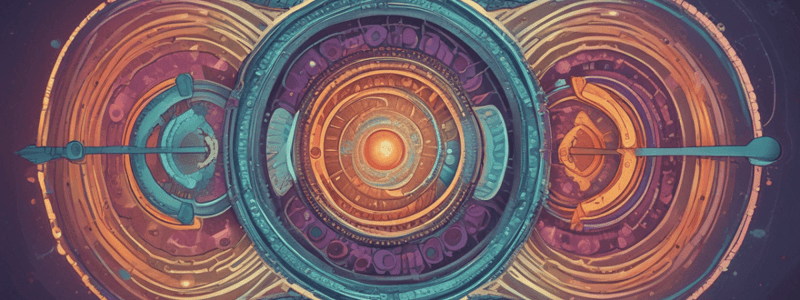Podcast
Questions and Answers
What is the purpose of meiosis in reproductive organs?
What is the purpose of meiosis in reproductive organs?
To form gametes with half the number of chromosomes
What happens to the genetic information during meiosis?
What happens to the genetic information during meiosis?
Copies of the genetic information are made, and the cell divides twice to form four gametes with a single set of chromosomes
What is the result of fertilization?
What is the result of fertilization?
A zygote with the normal number of chromosomes
What is the main difference between sexual and asexual reproduction?
What is the main difference between sexual and asexual reproduction?
What is the structure of DNA?
What is the structure of DNA?
What is the function of a gene?
What is the function of a gene?
What is the genome of an organism?
What is the genome of an organism?
What is the difference between genotype and phenotype?
What is the difference between genotype and phenotype?
What is an allele?
What is an allele?
What is the result of asexual reproduction?
What is the result of asexual reproduction?
What is the term used to describe the genetic makeup of an individual that has two copies of the same allele, either dominant or recessive?
What is the term used to describe the genetic makeup of an individual that has two copies of the same allele, either dominant or recessive?
What is the purpose of a Punnett square diagram in genetics?
What is the purpose of a Punnett square diagram in genetics?
What is the difference between a dominant and recessive allele?
What is the difference between a dominant and recessive allele?
What is the term used to describe an individual who carries a recessive allele but does not express it?
What is the term used to describe an individual who carries a recessive allele but does not express it?
What is the advantage of sexual reproduction in terms of variation?
What is the advantage of sexual reproduction in terms of variation?
What determines the sex of an individual in humans?
What determines the sex of an individual in humans?
What is the significance of Gregor Mendel's discovery in the mid-19th century?
What is the significance of Gregor Mendel's discovery in the mid-19th century?
What is the function of the four bases in DNA?
What is the function of the four bases in DNA?
What is the structure of DNA?
What is the structure of DNA?
What is the role of Watson, Crick, Wilkins, and Franklin in the development of the DNA model?
What is the role of Watson, Crick, Wilkins, and Franklin in the development of the DNA model?
Flashcards are hidden until you start studying
Study Notes
Meiosis
- Meiosis is a type of cell division that occurs in reproductive organs to form gametes.
- Meiosis halves the number of chromosomes in gametes, resulting in genetically different gametes.
- The process of meiosis involves copying genetic information, dividing twice, and forming four gametes with a single set of chromosomes.
Types of Reproduction
- There are two types of reproduction: sexual and asexual.
- Sexual reproduction involves the fusion of male and female gametes, resulting in genetic variation in offspring.
- Asexual reproduction involves only one parent and no fusion of gametes, resulting in genetically identical offspring (clones).
DNA, Genes, and Chromosomes
- DNA is a polymer made up of two strands that form a double helix.
- DNA is contained in structures called chromosomes.
- A gene is a small section of DNA on a chromosome that codes for a particular sequence of amino acids to make a specific protein.
- The genome of an organism is the entire genetic material of that organism.
- Every chromosome has a pair, resulting in two copies of each gene in every genome.
Inheritance
- Some characteristics are controlled by one gene, and different versions of genes are called alleles.
- The genotype (set of alleles) determines the phenotype (physical characteristic).
- A dominant allele is always expressed when present, while a recessive allele is only expressed when there are two copies of it.
- Punnett square diagrams can be used to predict the genotypes of offspring.
Inherited Disorders
- Polydactyly is an inherited disorder caused by a dominant allele, resulting in extra digits.
- Cystic fibrosis is an inherited disorder caused by a recessive allele, resulting in lung problems due to a faulty cell membrane protein.
- An individual can be a carrier of a recessive disorder but not of a dominant disorder.
Sex Determination
- Ordinary human body cells contain 23 pairs of chromosomes, with one pair carrying the genes that determine sex.
- In females, the sex chromosomes are XX, while in males, the sex chromosomes are XY.
Advantages of Reproduction
- Sexual reproduction produces variation in offspring, which can lead to a survival advantage through natural selection.
- Asexual reproduction requires only one parent, is more time and energy efficient, and allows for faster reproduction and many identical offspring.
Development of Genetics
- Gregor Mendel's breeding experiments on plants in the mid-19th century laid the foundation for modern genetics.
- The discovery of chromosomes and their behavior during cell division led to the idea that genes are located on chromosomes.
- The discovery of DNA's structure and function in the mid-20th century led to the development of the gene theory.
DNA and Protein Synthesis
- DNA is made up of nucleotides, which are composed of sugar, phosphate, and one of four bases.
- The sequence of three bases codes for a particular amino acid, which is assembled into a protein chain.
- Proteins are synthesized on ribosomes according to a template, and their unique shape enables them to perform specific functions.
- Mutations can occur in DNA, resulting in changes to the protein synthesised by a gene.
Studying That Suits You
Use AI to generate personalized quizzes and flashcards to suit your learning preferences.




